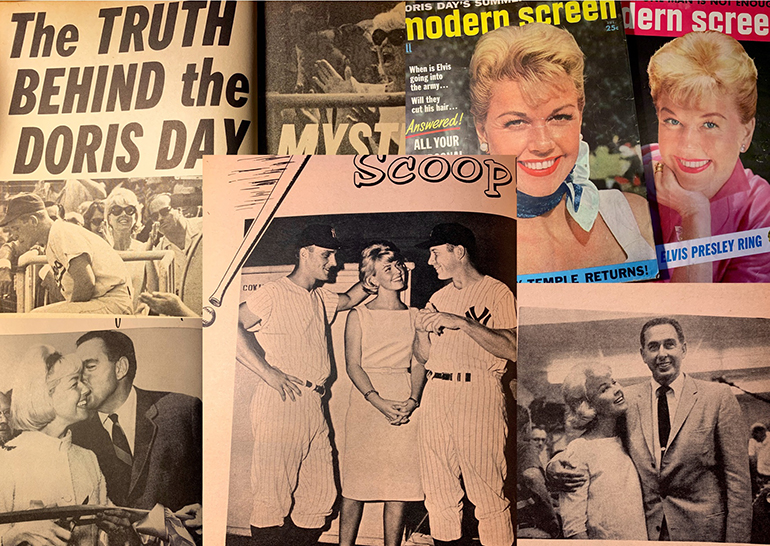“Dear Doris Day: I suggest you speak to Kim Novak before you do anything.” Fan magazines often used the “open letter” format to chastise stars or warn them off bad behavior: “Dear Troy: Please cool it! That fire you’ve been playing with, we mean” (The editors, Modern Screen, Jan 1962). “Dear Juliet Prowse: You seem to be doing everything in your power to put those black marks against you in the producers’ books” (Victoria Cole, Screen Stars, Aug 1961). Columnist Rona Barrett’s open letter to Day (Motion Picture, March 1963) was unusually brief and carefully coded. But any Tinseltown insider, and the rare close reader of the fan mags, would have known precisely what she meant.
Barrett was drawing a parallel between Day’s suspected dalliance with Dodgers shortstop Maury Wills and Novak’s presumed romance with Sammy Davis Jr. a couple of years earlier. In reality the two situations were quite different. Novak and Davis had been single, theoretically free to follow their hearts, while both Day and Wills were married. But what mattered to the movie world, in each instance, was not chastity or fidelity but the consequence of color: his skin, her hair. Blondes didn’t carry on with black men in Fifties and Sixties Hollywood, not if they were popular box office draws, and especially not if they were the “All-American Girl” who could command an eight-picture, $26 million deal with a major studio (Helen Hendricks, “The Secrets Doris Day Won’t Reveal,” Silver Screen, June 1962).
To her death, Day denied the affair with Wills, as has Novak re Davis. But in 1962 and early 1963 something was brewing to threaten the image of the “beaming,” “zestful,” “daffodil-headed” star (Hendricks, Silver Screen). The trouble started with rumors that Day and her husband-manager, Martin Melcher, were estranged. And then the baseball allusions proliferated:
It’s rumored that the marital troubles are rooted in Doris’ sudden addiction to baseball. Understand she’s prone to gift-giving she enjoys the game so much. — columnist Jane Reese Williams, Movie Life, Feb 1963
Last December the papers hinted that Doris’ third marriage might be called out on a foul after almost twelve years. We hope it’s not so. —“Strike Three A-Coming?” Movie Mirror, March 1963
The speculation quickly became more pointed, asking, “Is Doris Day in love with a Dodger?” (“Jimmy Hoffa and the Doris Day Rumors!” Modern Screen, Feb 1963). The columnist Mike Connolly, known for his insider euphemisms, named a name. He cited rumors “that Doris, a staunch fan of the Dodgers’ baseball team, would go into independent production with Dodgers star Maury Wills” (Screen Stories, Jan 1963). So did an article in Motion Picture (“Revealed!” Feb 1963). In the latter article, Hollywood’s reflexive racism showed clearly in a stunning non sequitur: “Insiders” doubted the Day-Wills rumors, “but couldn’t forget that Doris’ own ex-stepmother is a Negro — Luvenia Williams Kappelhoff, whose marriage to her father, Bill Kappelhoff, Doris refused to attend in 1961.”
At first the publicity machine tried deflection, suggesting other candidates for Doris’ rumored “mystery man” (Photoplay, Feb 1963) — if fans were to believe her capable of infidelity, the fan mags seemed to be saying, let it at least be with a white man! Possibilities included Day’s Jumbo co-star, Stephen Boyd, who was “flabbergasted” by the rumors, and Yankees star Mickey Mantle (Modern Screen, Feb 1963; Movie Mirror, April 1963). (In later years, Mantle declared the rumor about him and Day to be true; so, too, did Maury Wills.)
But by the time the 1963 baseball season rolled around, the fix was in. Melcher, who had moved into “a small bachelor suite in a Sunset Boulevard hotel” (Modern Screen, Feb 1963), returned home, and corrective items began appearing in the gossip columns and feature pages. Mike Connolly opened his April Screen Stories column with a large photo of Doris and Marty, smiling happily as they cut the ribbon for a new hotel they’d built in Palo Alto. The next month Louella Parsons highlighted the “Motoring Melchers”:
Tired of dodging rumor hounds about their marital situation, Doris Day and Marty Melcher took off on a motor trip to Texas all by their lonesome. But not before Marty presented Doris with a $16,000 heart-shaped diamond for a Valentine! I’ve said all along that these two didn’t break up — and I’m still saying it! — Modern Screen, May 1963
And, coming full circle, the September issue of Movieland and TV Time, in a multi-star feature on “The Many Faces of Love,” used Doris and Marty as exemplars of married love:
Everybody knows married love has its ups and downs and no one knows better than the Marty Melchers! Early this year there were all sorts of rumors, but [now] things couldn’t look better. It all started ‘cause Doris had another love… watching baseball games! Well, we know a couple who almost split up because he stirred his coffee too long!
* “Doris, who is noted for being practically a recluse, suddenly tossed caution to the winds, and adopted a free association with the colorful L.A. Dodgers” (Jean Mills, “The Truth Behind the Doris Day Mystery,” Movie Mirror, April 1963).
Image credits, clockwise from upper left: (1) Movie Mirror Apr 1963; (2) Modern Screen July 1957; (3) Modern Screen Apr 1957; (4) Modern Screen July 1963; (5) Movieland and TV Time Jan 1962; (6) Screen Stories Apr 1963.




Lots of fun dislodging memories associated with certain posts. The good part is not having a “heads up” on what is about to grab you and take you one place or another. Good stuff!
Like!! Thank you for publishing this awesome article.